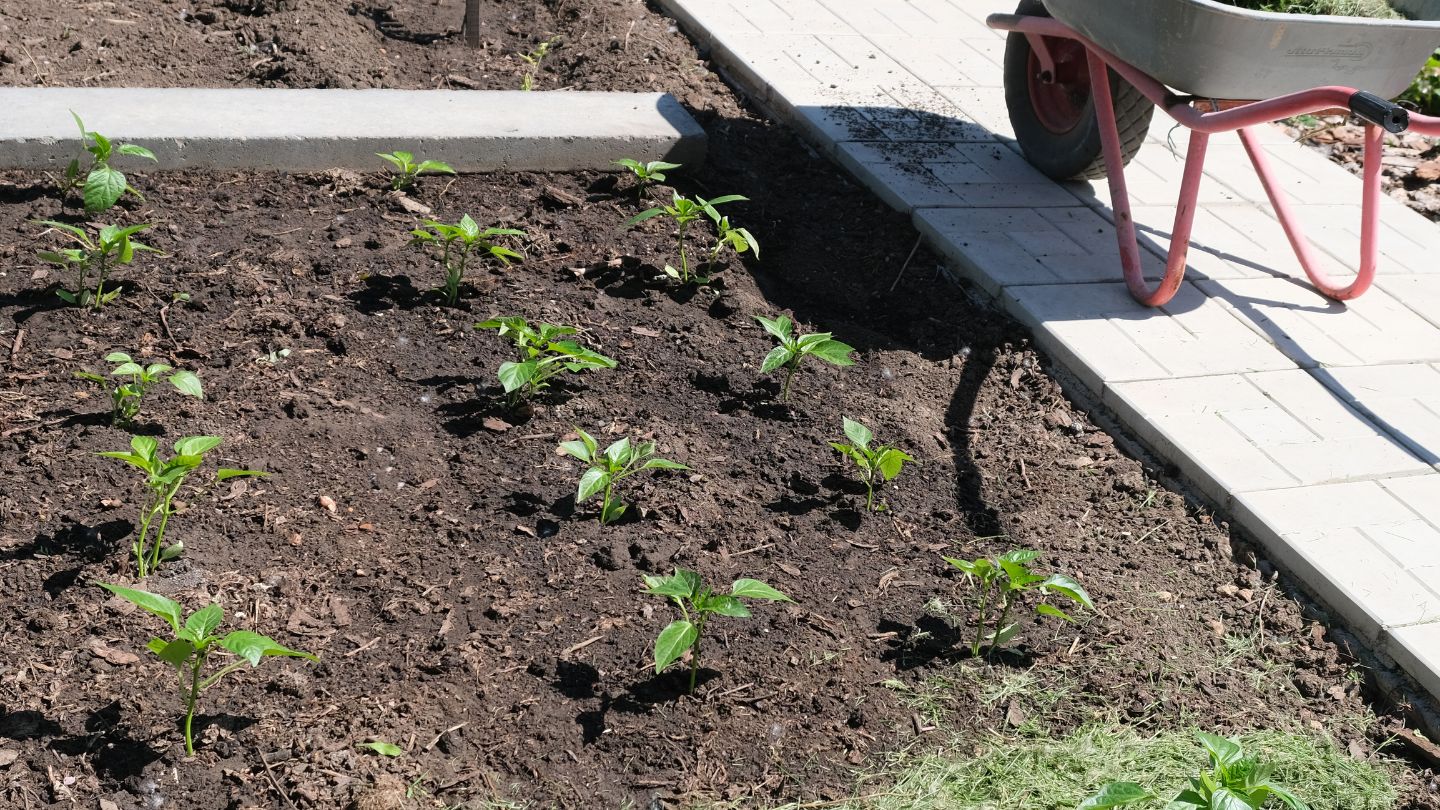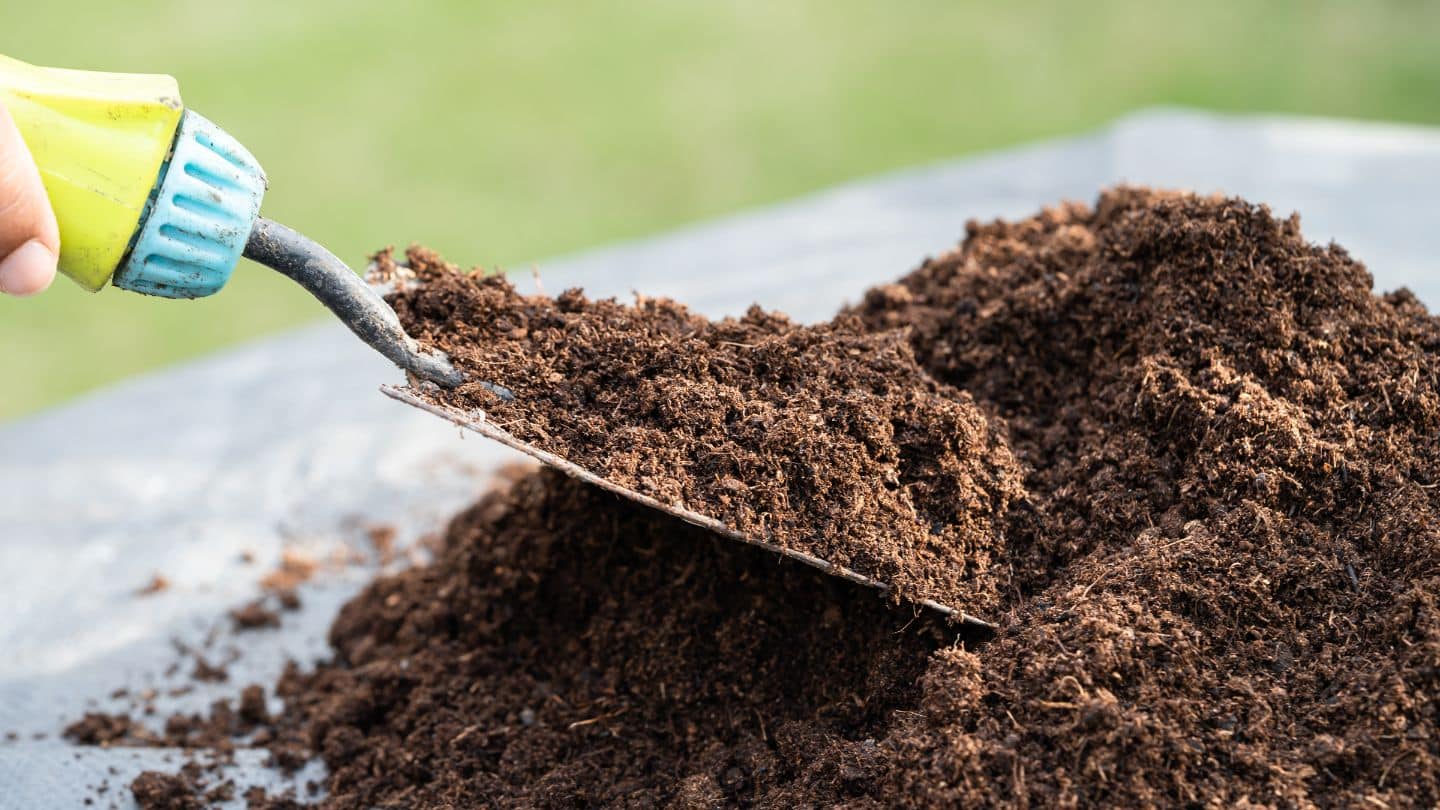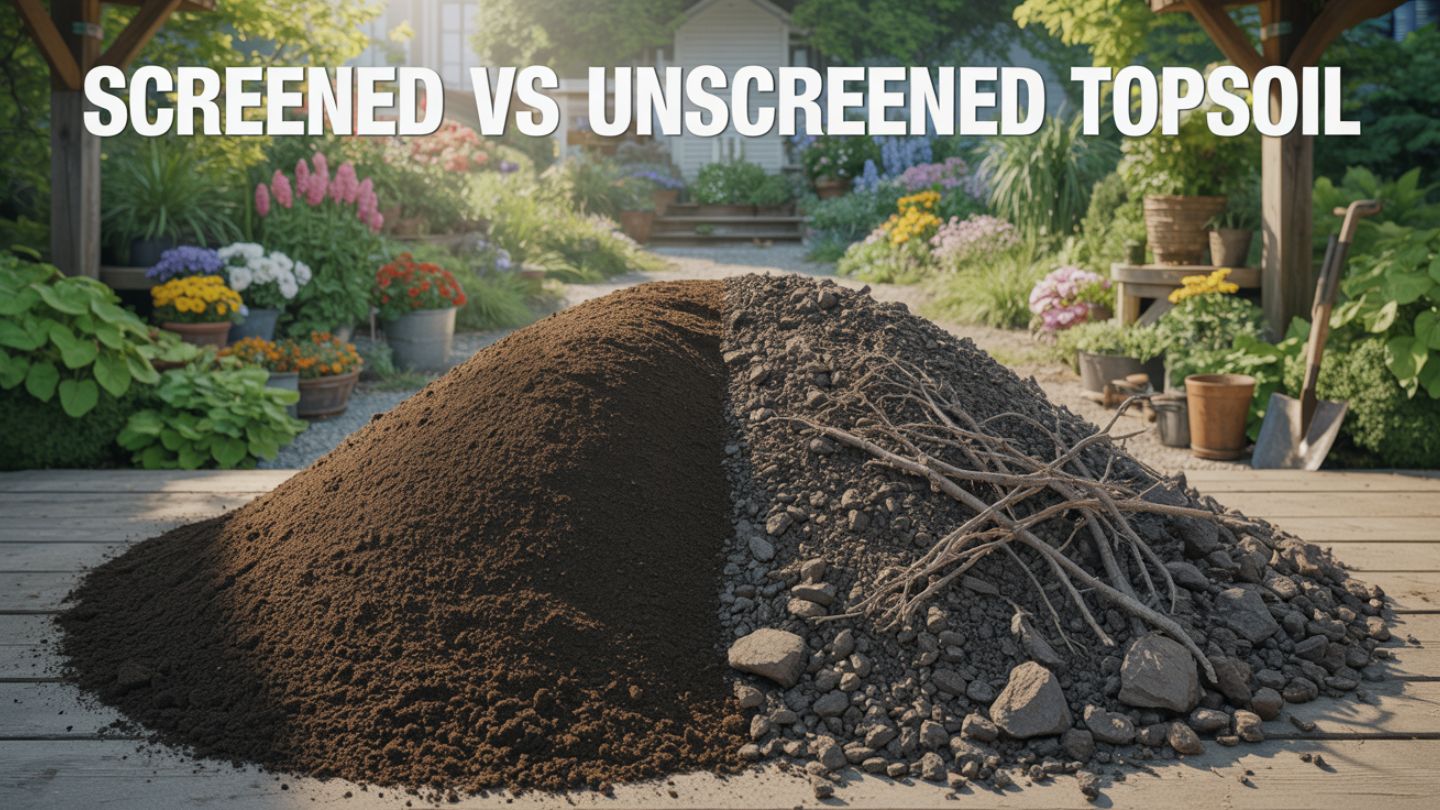Healthy, nutrient-rich soil forms the foundation of every thriving garden. Whether you’re laying sod, planting flower beds, or filling new landscape areas, choosing the right topsoil directly influences your success. Yet, many homeowners struggle to decide between screened vs unscreened topsoil. While they may sound similar, the difference lies in texture, composition, and suitability for specific gardening applications.
If you’re planning a garden project in Alpharetta, understanding what is screened topsoil and how it differs from its unscreened counterpart can help you create a stronger, healthier foundation for growth.
What Is Screened Topsoil?
Screened topsoil is natural soil that has been processed through mechanical screens to remove large debris such as rocks, roots, and clumps. This screening process creates a finer, more consistent texture ideal for planting, leveling, and landscaping projects.
Gardeners and landscapers often favor screened topsoil because it’s easier to spread and mix with compost or fertilizer. It provides even coverage and ensures plants have better access to nutrients and moisture. When people ask what is screened topsoil used for, the answer covers a wide range of applications; from seeding new lawns to creating raised garden beds or top dressing existing turf.
Screening also enhances soil drainage and aeration, preventing root compaction and improving oxygen flow. The result is a smoother, nutrient-rich growing medium that supports strong root systems and consistent plant development. Understanding these qualities can also help when comparing soil types in garden soil vs topsoil to determine which best suits your garden’s needs.
What Is Unscreened Topsoil?
Unscreened topsoil is the raw, unprocessed soil straight from the ground. It contains the same organic matter, minerals, and nutrients as screened soil but includes natural debris like stones, sticks, and clods. While this might seem like a drawback, unscreened soil has its advantages; particularly for large-scale projects that require bulk filling rather than precision planting.
Homeowners asking what is unscreened topsoil will find that it’s commonly used for leveling uneven areas, building berms, or filling low spots in the yard. Because it hasn’t been processed, it’s more affordable than screened soil and ideal for foundational work where soil quality consistency isn’t as critical.
The main difference between screened and unscreened topsoil is the refinement process. Unscreened soil may be coarser, but its natural organic content still contributes to healthy soil structure once blended and compacted correctly. This makes it helpful to understand when to use each option, as detailed in navigating the world of topsoil.
Screened vs Unscreened Topsoil: Key Differences
Choosing between screened and unscreened topsoil depends on your project’s goals. Each serves a unique purpose and offers distinct advantages.
Texture and Composition
Screened topsoil has a uniform texture, free from clumps and large debris. This makes it easier to spread evenly and integrate into gardens or lawns. Unscreened topsoil, meanwhile, is coarser and less consistent, often containing materials that require manual removal before use in planting applications.
Nutrient Availability
Both screened and unscreened topsoil contain essential nutrients, but screening allows for better soil-to-plant contact. The finer texture promotes even nutrient distribution and moisture retention; ideal for growing grass, vegetables, and ornamental plants.
Drainage and Aeration
Screened soil provides excellent drainage, which prevents waterlogging and root rot. Unscreened soil, due to its denser composition, can retain more water but may struggle with aeration in high-clay environments.
Cost and Use
Unscreened topsoil is more economical and suitable for large fill projects. Screened topsoil is slightly more expensive but provides better results in gardens and landscapes where plant health and appearance matter.
Understanding these distinctions helps you decide when to use screened vs unscreened topsoil for grass or garden installations in Alpharetta’s variable climate.
What Is Screened Topsoil Used For?

Screened topsoil is a versatile, all-purpose material used for several landscaping and gardening needs:
- Lawn Preparation and Seeding: Its smooth texture promotes even seed distribution and quick germination.
- Raised Beds and Planters: Provides consistent nutrient access for vegetables, herbs, and flowers.
- Top Dressing: Ideal for refreshing existing lawns and improving soil quality.
- Flower Beds and Borders: Helps plants root deeply and absorb nutrients efficiently.
- Soil Amendment: Mix with compost to improve fertility and organic content.
For homeowners deciding on screened vs unscreened topsoil for grass, screened soil remains the preferred option due to its fine, uniform consistency that supports healthy lawn establishment.
Uses for Unscreened Topsoil
While not as refined, unscreened soil plays a vital role in landscaping and construction projects that demand large quantities of soil for base layers or grading.
- Filling Depressions: It’s ideal for filling large holes or uneven ground before adding screened soil on top.
- Creating Embankments or Berms: Unscreened soil provides stability for large mounds or contours.
- Foundation Layers: Often used beneath patios or driveways as a compact base before final surfacing materials are applied.
- Erosion Control: Works well in areas that require large soil volumes to prevent runoff.
Unscreened soil can also be mixed with compost or screened material to enhance its structure for planting purposes.
Screened vs Unscreened Topsoil for Grass
When preparing to seed or sod a lawn, the choice of topsoil can directly affect root growth and turf longevity. Screened soil allows for even seed placement and ensures the roots penetrate smoothly. It reduces air pockets and provides superior drainage; two critical factors in establishing healthy turf.
Unscreened soil, while cheaper, may create uneven surfaces or clumps that disrupt seed distribution. For long-term lawn health and a professional appearance, most experts recommend starting with screened topsoil or adding a screened layer over a base of unscreened soil for cost efficiency.
The Difference Between Screened and Unscreened Topsoil in Alpharetta Gardens
In Alpharetta’s varied soil conditions; ranging from sandy loam to clay; screened soil offers greater consistency and adaptability. It’s particularly beneficial in residential areas where precision and visual appeal are priorities. Unscreened soil remains valuable for large landscaping projects, especially when cost management and bulk coverage are key considerations.
In essence, the screened vs unscreened topsoil decision should align with your end goal: use screened for surface-level planting and finishing, and unscreened for foundational layers or bulk fill.
Environmental Benefits of Using Quality Topsoil

Topsoil serves as a living ecosystem that supports microorganisms, stores nutrients, and facilitates water absorption. Choosing the right type; screened or unscreened; ensures sustainability and soil health for years to come.
Properly sourced topsoil improves drainage, prevents runoff, and restores nutrient balance to urban gardens affected by construction or erosion. Using locally sourced topsoil also reduces transportation emissions, supporting Alpharetta’s eco-conscious landscaping initiatives. Understanding soil composition and layering methods outlined in difference between topsoil and fill dirt can also guide environmentally responsible choices when preparing landscape foundations.
Expert Tips for Choosing the Right Topsoil
- Test Your Soil First: Conduct a soil test to understand nutrient composition and texture.
- Consider Your Project Scale: Use screened soil for planting areas and unscreened for filling or leveling.
- Inspect Moisture Content: Avoid overly wet soil, which can compact easily and reduce root growth.
- Buy from Reputable Suppliers: Ensure your supplier offers high-quality, contaminant-free material.
- Plan for Delivery Access: Prepare your property for efficient drop-off and distribution.
Maintaining Topsoil Quality Over Time
Even high-quality topsoil requires maintenance to sustain performance. Add organic compost annually to maintain fertility, rake periodically to prevent compaction, and monitor pH levels for balanced plant growth.
When using screened vs unscreened topsoil combinations, maintain surface layers carefully to avoid erosion or nutrient depletion. Regular upkeep ensures long-term health and stability for Alpharetta’s residential and commercial landscapes.
Wrapping Up
Selecting between screened vs unscreened topsoil ultimately comes down to purpose, budget, and performance expectations. Screened soil delivers smoother consistency and better drainage for gardens, flower beds, and lawns, while unscreened soil provides a cost-effective solution for filling and structural support. Understanding the difference between screened and unscreened topsoil helps you plan effectively and invest wisely in your landscape’s future.
Whether you’re establishing a new garden, leveling your yard, or preparing a base for grass installation, both screened and unscreened topsoil have vital roles in creating a healthy and balanced outdoor environment suited for Alpharetta’s unique conditions. For homeowners seeking quality materials and reliable topsoil delivery in Alpharetta, working with a professional supplier ensures your project starts with the best foundation possible.
Frequently Asked Questions
What is screened topsoil?
Screened topsoil is natural soil that has been processed through mesh screens to remove rocks, roots, and debris. This creates a fine, even texture that’s easy to spread and ideal for planting grass, garden beds, and landscaping projects. It provides better drainage, aeration, and nutrient distribution than unscreened soil.
What is unscreened topsoil used for?
Unscreened topsoil is unprocessed soil that contains natural debris and larger particles. It’s typically used for filling low spots, building up terrain, or as a base layer before adding screened topsoil. It’s a cost-effective choice for large-scale projects where soil texture uniformity isn’t essential.
What is the difference between screened and unscreened topsoil?
The main difference between screened and unscreened topsoil lies in refinement. Screened topsoil is filtered for consistency and ease of application, while unscreened soil is raw and coarser. Screened soil is better suited for planting and landscaping, whereas unscreened soil works best for foundational or grading purposes.
Is screened vs unscreened topsoil better for growing grass?
Screened topsoil is the better choice for growing grass because its smooth texture allows for even seeding and root penetration. It improves nutrient availability and prevents air pockets that can hinder lawn establishment. Unscreened soil can be used as a base, but a screened layer on top ensures better turf health and growth.


